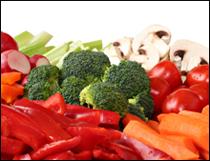 We are all pretty good about eating our green leafy vegetables, but how many of us venture much further beyond this?
We are all pretty good about eating our green leafy vegetables, but how many of us venture much further beyond this?
We eat spinach, broccoli and maybe different varieties of lettuce; but how often do we actually get creative with our vegetables and step outside the box and try things like radishes or eggplant (except perhaps as Eggplant Parmesan!)?
Yes, we do the carrots, tomatoes and celery in our salads but on a regular basis, if you pay attention to your side dishes for dinner, you might notice a pattern of similar vegetables week after week. Do you get at least five servings of fruit and vegetables a day? If you do, good for you! Now try and bump this up to 7 and then aim for 9!
It’s easier than you think to get your daily quota of fruit and vegetables, particularly if you think in terms of a rainbow.
Then not only will you eat enough servings (7 colors in a rainbow) but you’ll make sure you’ll cover the gamut of super nutrients (nutrients other than the usual protein, carbohydrates, fats etc.)
The Colors, The Health Benefits, The Fruit and Vegetable Options
Blue/Purple (Violet/Indigo/Blue)
- Rich in vitamin C, fiber and potassium
- Antioxidants and anti-inflammatory (assist arthritis sufferers)
- Promote heart and urinary tract health
- Improves memory function
- Reduces the risk of breast cancer
- Promote healthy aging
- Maintains healthy blood pressure
Eat black rice, eggplant, purple cabbage, plums, raisins, blueberries, blackberries, grapes, prunes
Green
- Rich in lutein
- Reduces the risk of colon cancer
- Promote vision health
Eat broccoli, kale, spinach, asparagus, brussel sprouts, green beans, cabbage, leeks, green peppers, okra, green apples, green grapes, honeydew
Yellow/Orange
- Rich in beta-carotene (the body converts this to vitamin A and vitamin C, E and folate, which reduces the risk of a woman giving birth to a child with brain or spinal cord defects
- Promotes vision, skin and heart health
Fights off environmental toxins, such as pollutants and second-hand cigarette smoke
Eat sweet potatoes, corn, squash, lemons, oranges, carrots, grapefruit, cantaloupe, mangoes, papayas, peaches, pineapples, bananas
Red
- Rich in vitamin C
- Reduces the risk of certain cancers
- Promotes heart and urinary tract health* Heals wounds
- Keeps gums and teeth healthy
Eat apples, cherries, pomegranates, red grapes, strawberries, cranberries, pink grapefruit, watermelon, beets, red onions, red peppers, tomatoes, red cabbage
According to statistics gathered by the Center for Disease Control in 2005, the average percentage of people who consumed fruit and vegetables more than five times a day was less than 35 percent across the nation. Washington DC was in the lead with 33 percent. Is there any wonder obesity, as a whole, is on the rise?
It’s not difficult to include more fruits and vegetables into your diet. A serving size is actually smaller than you think.
One medium piece of fruit or half a cup of cut up raw or cooked vegetables comprise one serving.
Here are some easy ways to incorporate more fruit and vegetables into your diet.
- Add fresh fruit (berries or banana) to your morning cereal or oatmeal.
- Blend some fresh or frozen berries with nonfat yogurt for a delicious antioxidant rich smoothie.
- Instead of refrigerating your fruit, place it on your kitchen counter in a pretty basket or bowl for a bit of kitchen art. This way, if you see it, you’ll reach for it!
- Toss up some spinach, tomatoes and avocado with your egg white omelet in the morning.
- Reach for an 8 oz. V8 vegetable juice and get a whole serving of vegetables.
- Make your own fruit and yogurt parfait by mixing nonfat plain yogurt with some strawberries, blueberries and some crunchy granola for a perfect 3 p.m. pick-me-up instead of the snickers bar you’re about to reach for.
- Make it fun — include the whole family, particularly the kids; let them help you pick out different vegetables. Make a game of getting the “vegetable rainbow” into your grocery cart.
- Grow a vegetable garden — either in your backyard or on your condo balcony in pots — there is nothing better than homegrown tomatoes.
As James Joseph, of the Human Nutrition Research Center of Aging at Tufts University in Boston, said, “The truth is that if grocery stores had the marketing muscle of drug companies, we would all be racing to try this miracle regimen of eating a color-packed diet full of fruits and vegetables. Patients would demand that their doctors prescribe it.”
Sources: www.5aday.org, www.timesonline.co.uk, www.healthyhawaii.com, www.fuitsandveggiesmatter.gov, www.cdc.gov
